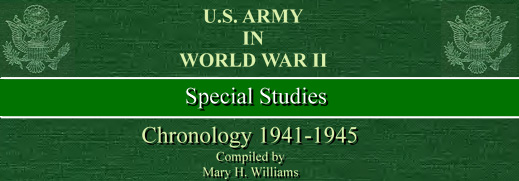

Foreword
The relationship of events in time is the essence of history. Chronology: 1941-1945 establishes the sequence of events from the time the first bombs on Pearl Harbor on 7 December 1941 until the instrument of surrender was signed aboard the USS Missouri in Tokyo Bay on 2 September 1945. The other volumes in the series United States Army in World War II recount in detail the various aspects of a complex global war--individual campaigns, grand strategy, logistics, support, and so forth. In this volume the reader can see the events of the war day by day in their sequence and contemporaneity, measure the scope of the global struggle, and begin to grasp the relation of the innumerable parts to the whole.
Washington, D.C.
23 June 1958R . W. STEPHENS
Maj. Gen., U.S.A.
Chief of Military History
Preface
The chronology is primarily one of tactical events of World War II from the time the United States was drawn into the conflict on 7 December 1941 until the surrender of Japan in 1945, with emphasis on ground action by United States armed forces. Air and naval co-operation, combat actions of foreign units--both Allied and enemy--and general events of world-wide interest are detailed within the scope of space limitations.
Geographically, events for the period from Pearl Harbor to the invasion of Normandy on 6 June 1944 are arranged in sequence from the Western Hemisphere westward around the world. From D Day to the end of the war the order is reversed, the action in western Europe taking precedence. The dates used are those of the area under discussion. Thus, the attack on Pearl Harbor is dated 7 December while the events occurring simultaneously in the Far East appear under 8 December. An exception has been made for the Gilberts and Marshalls campaign because the scene of engagement lies so near the lnternational Date Line and also because most of the records consulted are dated west longitude.
To itemize the materials used in the preparation of this work of reference would be tedious, if not impossible. Suffice it to say that the compiler consulted extensively After Action Reports, histories of units engaged, dispatches of the Allied commanders, and other primary sources, but for correctness and completeness relied heavily on the findings of the historians who have written and are writing other volumes for the UNITED STATES ARMY IN WORLD WAR II, on the History of United States Naval Operations in World War II by Samuel Eliot Morison, and on The Army Air Forces in World War II edited by Wesley Frank Craven and James Lea Cate.
The volume is the product of a co-operative effort of the Chronology Section--first of the Historical Division and then of the Office of the Chief of Military History. To one staff member, Miss Goldie Ann Kannmacher, the compiler is especially grateful for unstinting service throughout most of the life of the project. The assistance of Miss Betty Lee Belt in the project's initial stages is gratefully acknowledged. For directing the work of the staff during a six-month absence of the compiler, acknowledgments are due Maj. John M. Baker. Members of the staff who served it ably are Mrs. Margaret Leenhouts, Miss Mary G. Schuster, Miss Ruth Upson, Miss Grace Waibel, Miss Elizabeth Stribling, and the late Mrs. Priscilla White. Miss Lauretta Plockelman and Miss Jaqueline Van Hovel contributed valuable clerical assistance.
The compiler is also grateful to Dr. Kent Roberts Greenfield for his advice and moral support. To Miss Mary Ann Bacon, who edited the volume, to Nicholas J. Anthony for the Index, and to Mr. Israel Wice, Chief, General Reference Office, and his competent assistants, who acquired the materials used, I acknowledge my great indebtedness.
Washington, D.C.
21 February 1958MARY H. WILLIAMS